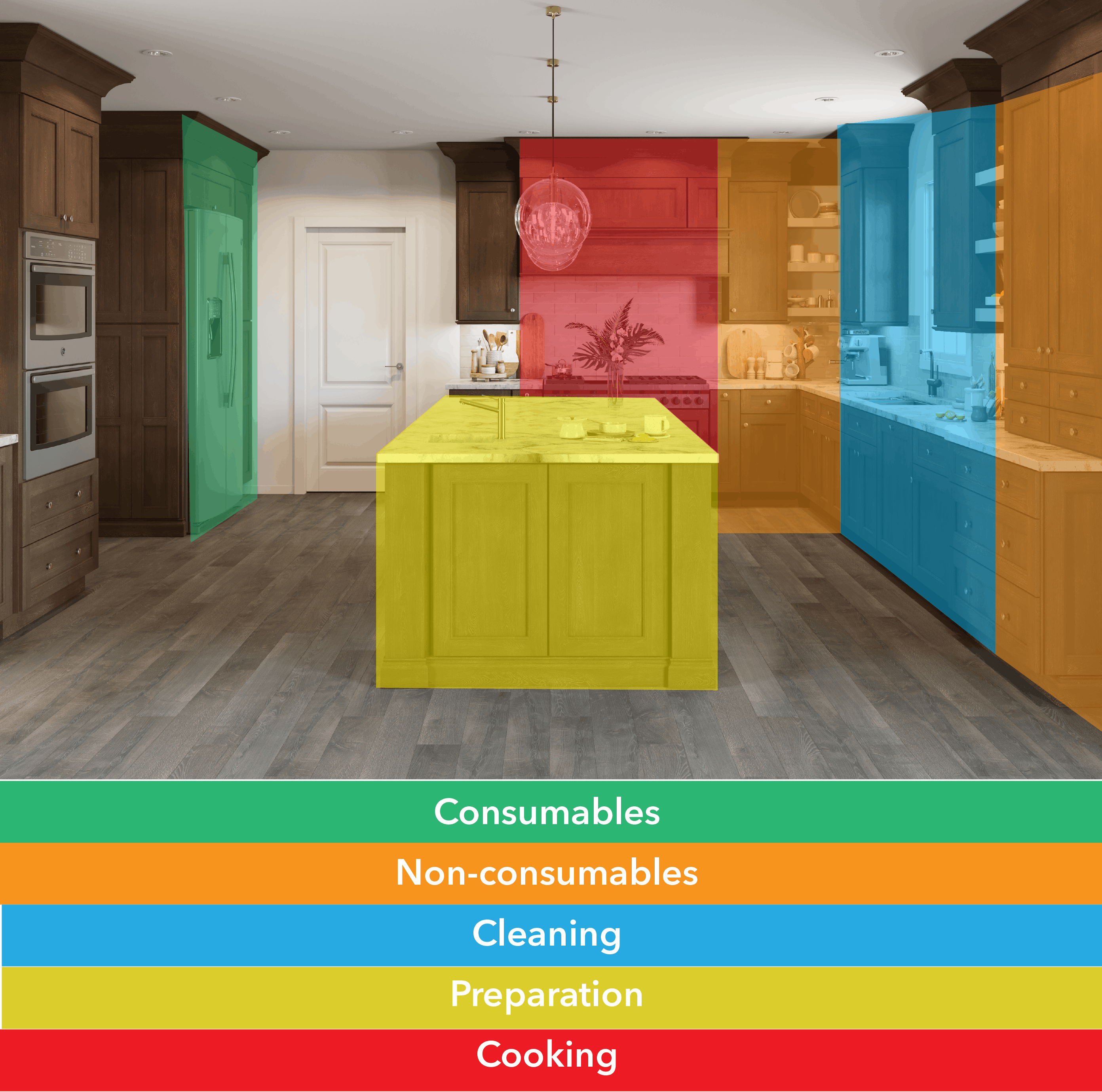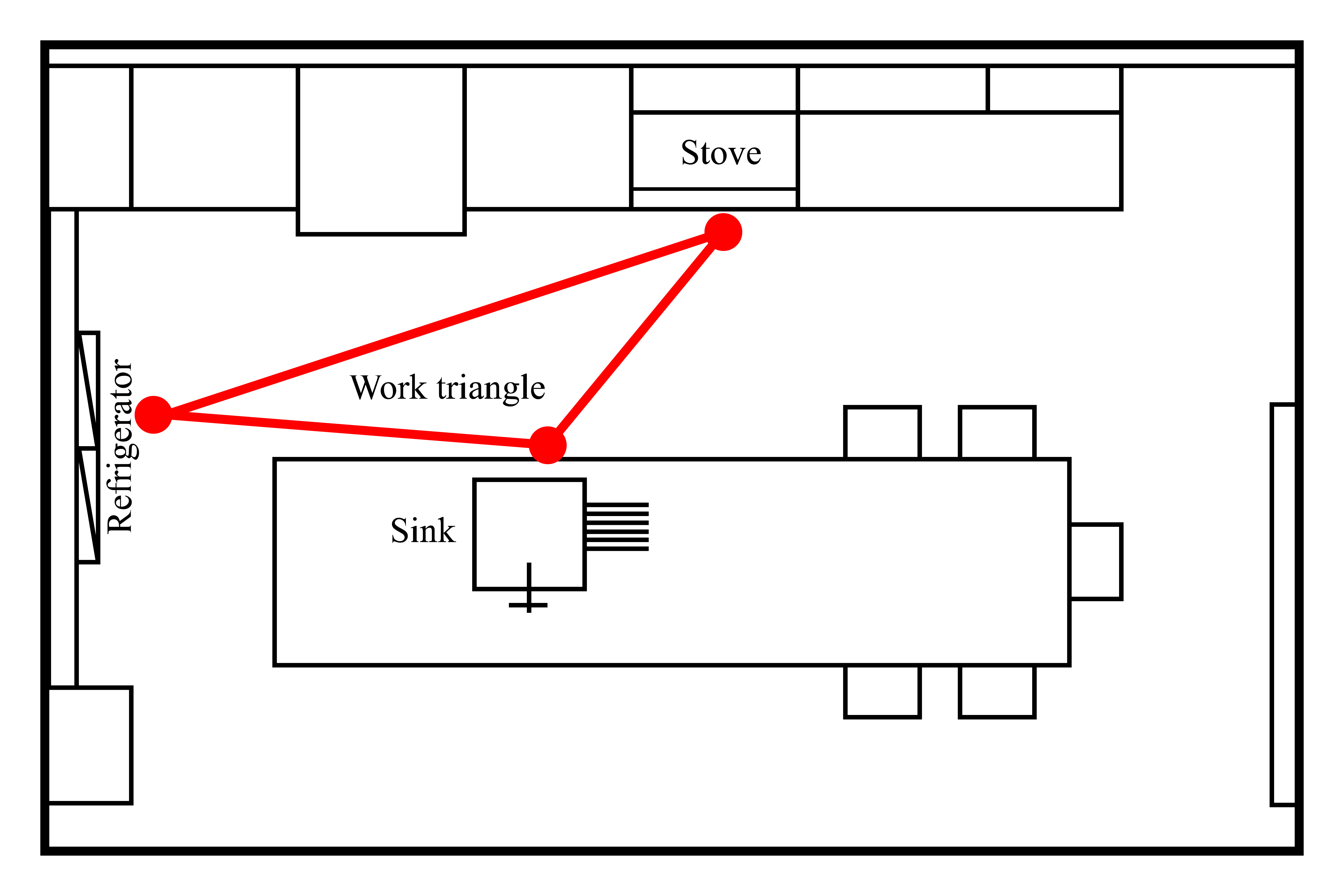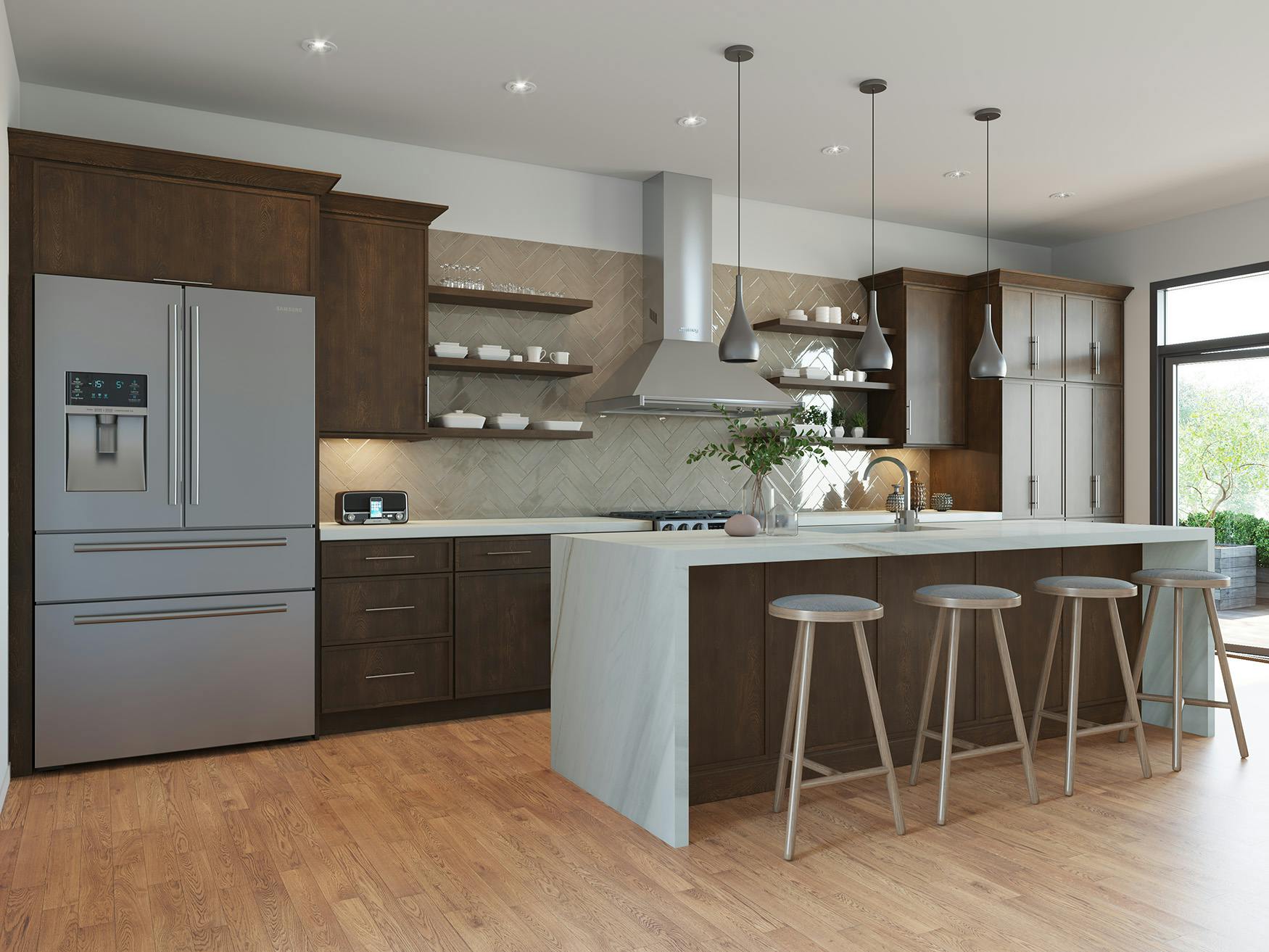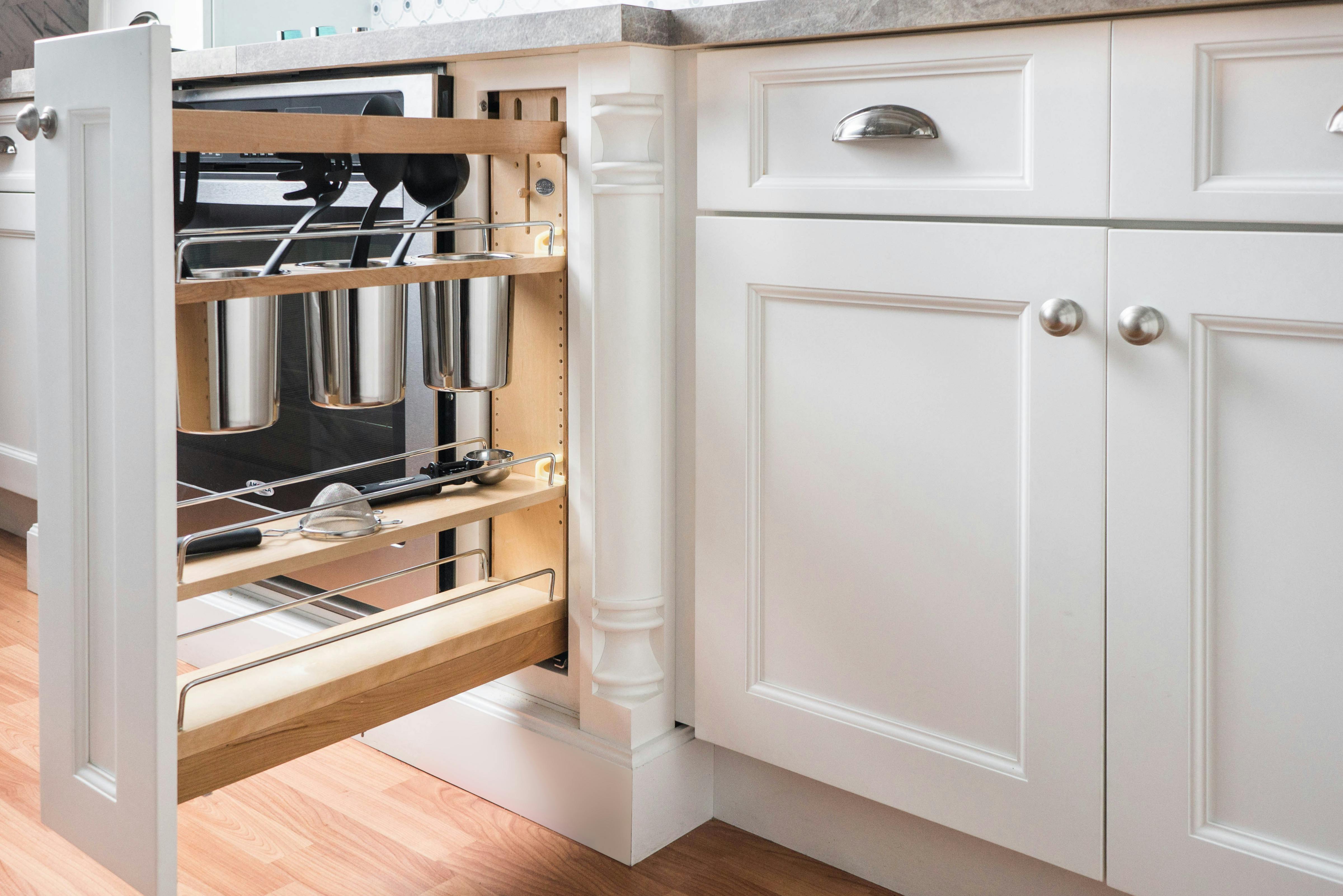7 Kitchen Design Principles You Need to Know
Kitchen design principles create efficient, functional spaces. They guide the use of every element in the kitchen from flooring to backsplash, colors, and textures. With an understanding of these 7 design principles, you can bring together your picture-perfect kitchen that is both functional and beautiful.
The principles include:
- Space planning
- Kitchen work zones
- Kitchen work triangle
- Focal points
- Scale and proportion
- Ergonomics
- Storage Solutions
The key to a well-designed kitchen is to prioritize functionality and specific needs, such as ample preparation space and entertainment areas. It's also important to ensure proper lighting and enough counter space to complete your kitchen's design.
Space Planning

The first step in kitchen design is properly planning your space and layout. Your chosen layout should make the cooking process as streamlined and efficient as possible.
Remember to maintain adequate walking space while cabinet doors are open- maintain a space between 42-48 inches for smooth traffic flow.
Space Planning Points to Ponder
- Ensure a minimum of 15 inches of counter space on either side of the range
- The food prep area is best placed between the fridge and sink
- Islands with a second sink can be a great addition and serve multiple purposes
- Consider the work sequence- design your kitchen in the sequence of food prep to minimize the number of steps taken. For example, the prep station should contain all cutting boards, mixing bowls, knives, etc., the cooking station should be near the oven, grill, microwave, etc., and the serving station should contain the cutlery, dishes, glasses, etc.
Kitchen Work Zones

The kitchen work zone is a popular way of dividing the kitchen layout according to function. Each work site functions separately, optimizing efficiency. Food storage for consumable and non-consumable goods, food prep, cooking, and cleaning are popular work zones.
- Consumable zone- fridge and pantry
- Preparation zone- worktops
- Non-consumable zone- cupboards and drawers for storage
- Cooking zone- oven and microwave
- Cleaning zone- sink/dishwasher
Kitchen Work Zones Points to Ponder
- Consider the flow of traffic in and out of the kitchen to minimize disruption during daily activities.
- Organize your fridge and pantry so your most used items are within easy reach, and store occasionally used items out of the way.
- Your prep zone should be as close to the oven as possible. Include spices and regularly used utensils in this area.
- Store dishes close to your cleaning zone for easy storage.
- Utilize under-cabinet solutions for easy access to your cleaning supplies.
The Kitchen Work Triangle

The kitchen work triangle is crucial for an efficient kitchen. Ideally, the stove, fridge, and sink should be in a triangular layout to maximize efficiency and cut down on unnecessary steps taken while cooking. This triangle should be no less than 13 feet and no more than 26 feet.
Kitchen Work Triangle Points to Ponder
- No major traffic should cross through the triangle.
- There should be no obstacles between the points of the triangle.
- The work triangle can work in any kitchen layout- L-shape, U-shape, straight, or even with an island.
- Some consider the work triangle outdated- it is a good design principle, but modern family needs often differ from the strict layout of the triangle.
Kitchen Focal Points

Focal points in a kitchen are attention-grabbing elements like stovetops, backsplashes, hoods, islands, or even a large piece of art. The use of bold, contrasting colors will enhance the focal points, and create visual interest.
Focal Points Ideas to Ponder
- Focal points will anchor the design in the room and will prevent the space from feeling chaotic or dull.
- Highlight specific features using light, color, and texture.
- Consider fun furniture, a textured feature wall, colorful appliances, and eye-catching fixtures.
- Accent cabinet doors, like glass front doors, can create a beautiful focal point.
- Harmony and unity are important in ensuring a cohesive and consistent kitchen design. Whatever your chosen aesthetic, all items should fit the same mood and style for a pulled-together look. Cabinetry styles, counters, and appliances should all blend seamlessly for an attractive look.
The Effect of Scale and Proportion on Kitchen Design

The principles of scale and proportion ensure that every element in the kitchen is appropriately sized for the space and with one another and is what makes a room feel warm and inviting.
Scale and Proportion Points to Ponder
- Proportion refers to how well the pieces in your kitchen fit together, and scale refers to how the pieces fit in your space. For example, an overstuffed sofa in a small family room would be the wrong scale. An oval-shaped object would be the wrong proportion for a circular table.
- Consider room size, ceiling height, and cabinetry dimensions when designing a kitchen.
- Proportion is used to understand design elements like the shape, size, and color of an object.
- Use the “golden ratio”- the ratio of 60/40 is a typical balance designers use. Fill 60% of your space with furniture, leaving 40% open so the space doesn’t feel overcrowded.
Ergonomic Kitchen Design
Ergonomics centers around a user-centered design to create an efficient kitchen. This means considering the proper placement of appliances and workstations. Some aspects of ergonomics in the kitchen include safety, comfort, ease of use, productivity, and performance.
Ergonomic Design Points to Ponder
Common ergonomic issues in the kitchen are muscle strains, carpal tunnel syndrome, and other similar injuries.
Some ways to make your kitchen more ergonomic:
- The kitchen should be tailored to your specific height. It is recommended to place countertops 10 cm below elbow height.
- Raise your sink 10-15 cm higher than the worktop to avoid back pain while washing dishes.
- Ideally, you should be able to manage everything in your kitchen easily without much thought.
- Upper cabinets shouldn’t be too high- you want to avoid having to use a step ladder to get down frequently used items.
Universal Design is a popular point of ergonomics that considers the needs of all types of people for a functional and safe cooking environment. Key aspects of universal design include utilizing multiple areas for different uses, safety measures low physical effort, and appropriate space for people of varying abilities.
Rhythm in the Kitchen

Creating patterns and contrast brings visual interest to your kitchen, which can be achieved through repeating colors, shapes, or textures.
Rhythm Points to Ponder
- Rhythm can be applied by echoing a motif throughout the kitchen.
- Rhythm can be achieved in three ways:
Random- repeating elements randomly.
Regular- design follows the same interval repeatedly.
Alternating- repeating more than one element in a design. - Use different materials, like wood and metal accents, to achieve a rhythm in your kitchen design.
- A great way to achieve rhythm is with shapes- curved chairs can offset the sharp edges of a kitchen table.
- Gradation, using elements that progress from small to large or light to dark, will help move the eye from one side of the kitchen to the other.
Storage Solutions for an Organized Kitchen Design

There is one basic design principle you must remember- you can never have too much storage. Smart storage solutions mean you can always find items when you need them, and you can easily take inventory when creating your shopping lists.
Storage Solution Points to Ponder
- Drawer organizers, pull-outs and roll-outs are all highly efficient organization tools that will take your kitchen to the next level.
- Lazy Susan’s are a great way to organize a corner cabinet, which allows for maximum storage.
- If you have a small kitchen, don't worry. There are plenty of space-saving tips and tricks you can utilize while organizing. Our Space Saving Tips is a great resource for maximizing your small kitchen footprint.
- Tiered shelves for pantry items, spice racks, and clear storage bins are all great ways for cabinets and pantries to remain neat and organized.
- Whatever storage solutions you utilize, you should first consider all your needs in the kitchen, how often you cook and prepare food, and how much storage you require.
Keep This in Mind When you Start Designing Your Kitchen
The strategic placement of the essential parts of the kitchen, like the sink, stove, and dishwasher is essential to your kitchen design. Here’s what you need to keep in mind when designing your space:
- Fridge- ensure it has ample surrounding floor and counter space. The door should have plenty of room to swing open, allowing multiple people to pass by while it is open.
- Sink- traditionally placed beneath a window, the sink’s location usually determines the layout of the work triangle. The minimum counter lengths are 36 inches on one side and 24 inches on the other.
- Stove- the best place for the stove is along an exterior wall for efficient ventilation. A 21-30-inch clearance is a must for visibility and access to rear burners.
- Dishwasher- position it near the sink, and plan for more than one person using the dishwasher at the same time to allow for optimal functionality.
These 7 kitchen design principles, space planning, kitchen work zones, kitchen work triangle, focal points, scale and proportion, ergonomics, and storage solutions will ensure efficiency and flexibility in your kitchen. When applied, each design principle will make the most out of your space with both beauty and functionality.
For more design ideas, follow us on social media for daily inspirational content!
